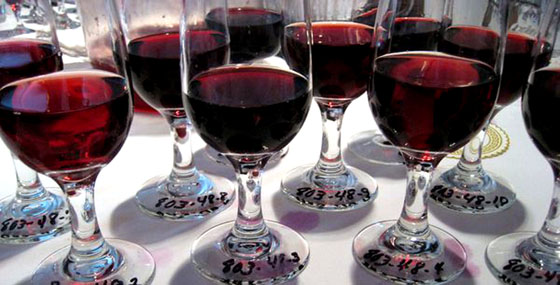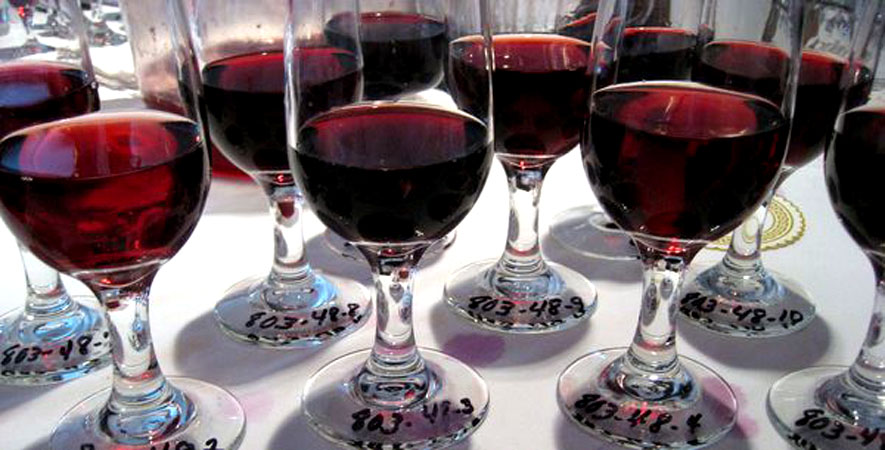 This holiday weekend, when you belly up to the tasting bars of your favorite local wineries — or any given winery, really — inevitably you will see on display bottles draped in shiny heavy medallions of bronze, silver, and gold. Annual beribboned medals of merit, glinting under lights positioned just so to draw your eye to their shiny pomp and circumstance. Tasting notes on flight sheets further explain the sight — this one won a silver, this one a double gold. And every now and again, you find the goose with the golden egg: The coveted Governor’s Cup. But do you ever wonder who awards these twinkly, weighty prizes? Who are these judges who deem it so that this bottle in this vintage stands apart from all others, amen?
This holiday weekend, when you belly up to the tasting bars of your favorite local wineries — or any given winery, really — inevitably you will see on display bottles draped in shiny heavy medallions of bronze, silver, and gold. Annual beribboned medals of merit, glinting under lights positioned just so to draw your eye to their shiny pomp and circumstance. Tasting notes on flight sheets further explain the sight — this one won a silver, this one a double gold. And every now and again, you find the goose with the golden egg: The coveted Governor’s Cup. But do you ever wonder who awards these twinkly, weighty prizes? Who are these judges who deem it so that this bottle in this vintage stands apart from all others, amen?
Me. I do.
Or I did, for the very first time this past August along with 22 other wine professionals from around the country (and, actually, one international appearance with a judge from France – fancy!). I was asked for the first time by the New York Wine & Grape Foundation’s President Jim Tresize to attend this past summer; to sit in judgment with my compatriots of the 773 entries in the annual New York Wine and Food Classic.
If you don’t know exactly what the Classic is, take note: It is, by and large, the biggest and most important competition for New York wines. Hundreds of producers hedge their annual bets, making multiple submissions into different categories, or perhaps just betting it all on one dark horse entry. I was honored to be asked to sit in. I hope to do it again.
I entered into it with a kind of humble awe — I’ve judged smaller competitions of various kinds, but, as a native eastern Long Islander and proponent of our good home-grown liquid culture, this felt somehow more personal, and that it required a particular concentration and attention that I was excited to muster and give. But a few people I spoke with in the industry beforehand seemed a little dubious about the competition — its seriousness, the ability to come out with winners of true distinction, the possibility that maybe there was more marketing at hand than merit, the possibility that some judges had agendas or just had no idea what they were doing.
What I can tell you is this. In the two and half days I was there, I saw quite a lot of passion for the New York wine industry — among my fellow judges; the staff; the volunteers; the folks from the NYWGF; the winemakers, the chefs and cooks who made food for us; everybody. There was an incredible and heartening amount of camaraderie that, as a New Yorker and a New York wine proponent, I was very invigorated to swim in.
But friendliness and stumping aside, I never got the notion that those around me did anything less than take the competition very, very seriously. Some had judged dozens of state competitions over the years in multiple states, and their familiarity not just with the local producers and their vintages, but with the odd-duck hybrid and labrusca grape varietals surprised me, and as much as I thought I knew about New York wine, made me realize there was so much more yet to learn.
But hybrids and labrusca in particular I know have been a point of debate, even on this very blog: Should these wines even be included? Are they cutting off the seriousness of the competition at its knees and holding back producers who make serious efforts at vitis vinifera? That’s a long conversation and I’m honestly not sure what its conclusion is. What I can offer is this: When I had to judge one Marquette against another or Frontenac among six other entries, at first I felt like a bit of a phony — I’d rarely had them before, and I wondered how fair this was to the winemaker. But the thing is, discerning quality of one over another offers a similar, familiar road to tread. I learned I quite like Marquette; I also learned that Frontenac has some serious personality disorder issues, ranging from pucker-tart to sticky sweet. And that’s where the whole issue of preference seems like it can muddy things up.
Still, when one stood out, it seemed like a great feat; a marvel. Who knew a hybrid could taste like that? And I can’t say I didn’t appreciate the wonder of that experience and was happy at the notion that a winemaker who believed in the merit of these grapes got some appreciation for his or her hard work. Because it is very, very hard and expensive work.
Did I agree with all of my fellow judges and the ultimate winners of the competition? This is where it gets tricky. What I learned was that no matter how impartial you try to be — weighing tannin, acid, fruit, texture and body, aromatics and flavor – there are things you simply like and don’t, and pushing past that to “does this wine have merit for what it is or not?” can be a tough nut. There were judges there who I could see loved the labrusca and hybrid underdogs, and only half-joked that they’d like to see one win the Governor’s Cup. Others I could see sniffed a little at the non-vitis vinifera competitors. There was one judge who told me she was partial to “weird” wines — oddball grapes that, presumably, made
her think, as opposed to a pretty, easier-to-understand chardonnay or merlot. (Ever drink any Himrod? Boy, that’ll make you ponder life.)
For me, the riesling category in particular was challenging. There is no doubt that Finger Lakes rieslings are abundant in acidity, at times searing like a saber — you might say it’s a calling card. So what you’re left with is the rest of the balancing equation. It would be hard to make an argument that Dr. Konstantin Frank’s semi-dry didn’t deserve the Gov’s Cup; it did. It’s a beautiful wine and I think goes a long way in the education department; that semi-dry doesn’t mean sickly sweet; that the old chestnut of balance is ever vital here and the ultimate perception of a wine on the palate.
Were there other rieslings I liked more? Yes. Definitely. But that 23 people from 23 different parts of the state, the country, and the world could agree upon Dr. Frank and the merits of that 2011 semi-dry bodes well for professional consensus. Despite my attraction to certain entries in the field — an exciting nose, a roller-coaster journey on the palate, even if that meant slightly less-than-perfect technical ducks-in-a-row — when I read my tasting notes later on I understood by the descriptors and exclamation points that an argument can made here for bias preference. Like the way that you just like certain people; are drawn to them from the get-go. Does that mean they are better than others? Maybe, maybe not.
I can also tell you that judging wines may sound like a ton of fun, but (really, truly) it is work. Not digging-a-ditch work, because I am well aware of the kind of work I do, and while its downsides are not something that I can gripe about to anyone except others who do this (because, really, it just sounds like whining to anyone else, and I couldn’t blame a soul for thinking it was) but it does require you to be serious. You aren’t sipping (and spitting — because you must, or perish) for pleasure. The act of concentrating and critically examining… anything for a full eight-hour work day is a job. People who work in quality control for, say, perfume or chocolate or anchovies or prosciutto work with yummy, lovely things. But it’s still a job. You’re not hanging out at a table with your buddies shooting the breeze and popping corks.
On the big judging day, I sipped and spat and evaluated: 8 red hybrids; 10 pinot noirs; 9 red vinifera blends; 6 red blends; 21 vinifera sparkling; 5 vinifera rose sparkling, 9 hybrid and labrusca sparkling; 9 medium-sweet riesling; 4 muscat; 12 white hybrid blends; 11 late harvest wines; and 12 spirits, for a total of 116 glasses of things to look at, swirl, sniff, sip, swoosh, spit, and come up with a sound opinion and consensus with the two very astute team judges at my table (veterans, both, who were wonderfully patient with my occasional catch-up moments) in a few minutes time per flight.
The next morning, the entries were narrowed to 50, all of which needed to be evaluated for final Best Of and Governor’s Cup status. That’s a total 166 in less than a day and a half. Less than a day and a half to pass judgment on a year of someone’s life.
Is it all fair? Well, I think that it’s as fair as it can be. I can say that it is done with great professionalism, respect, and at times earnestness. Do the medals mean something when you see them? Yes. They do. As much as the opinion of any critic in a magazine or paper or blog that you trust means something. Are we promoting New York Wines? Damn skippy we are. But ultimately, in that tasting room, medals aglow, you are the only one who can say whether something is good to you or not.
So I hate roller coasters, but I love crazy roller-coaster riesling. And while I might serve you one to you at my house, I learned that maybe it might not be the one that floats to the top of the heap. But that’s okay. Because weighty as those medals are, I believe that the rising tide floats all boats.

